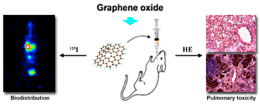マウスの気管内に投与された酸化グラフェンの生体内分布と肺毒性
Biodistribution and pulmonary toxicity of intratracheally instilled graphene oxide in mice
2013年4月5日 NPG Asia Materials 5, e4 (2013) doi:10.1038/am.2013.7
酸化グラフェン: 毒性試験

グラフェンやグラフェン誘導体は優れた物理的特性を持つため、例えば薬物送達担体など、多様な応用可能性が示唆されている。中国科学院上海応用物理研究所のChunhai Fan率いる研究チームはこのたび、こうしたグラフェン系ナノ材料を生物医学に利用する際に起こりうる安全性の問題を評価するため、マウスを使ってナノスケール酸化グラフェン(NGO)の分布と毒性を調べた。研究チームは、NGO 片をヨウ素の放射性同位体(125I)で標識して吸入曝露させた後、マウス体内での分布を追跡した。125I―NGO は、3か月の試験期間にわたってほとんど肺に留まり、そこで用量依存的な急性肺障害や慢性肺病変を引き起こすことがわかった。さらに、125I―NGOの分布は125Iイオンの分布と異なることも明らかになった。つまり、吸入されたNGOが、放射性吸着種を肺の奥深くに運び込んでいる可能性が高いことになる。この結果は、ヒトの健康への潜在的リスクを調べる必要性とNGO片の大きさを最適化して毒性を最低限にする必要性を浮き彫りにしている。
Graphene oxide: Toxicity testing
The remarkable physical properties of graphene and its derivatives suggest myriad potential uses for these carbon-based nanomaterials, such as drug delivery vehicles. To assess the potential safety issues surrounding their biomedical use, a team led by Chunhai Fan at the Shanghai Institute of Applied Physics in China examined the distribution and toxicity of nanoscale graphene oxide (NGO) in mice. The researchers labelled NGO flakes with a radioisotope of iodine (125I) to trace their distribution in the animals following exposure by inhalation. Over the course of the three-month trial, 125I–NGO was found to have been largely retained in the lung, where it caused dose-dependent acute lung injury and chronic pulmonary lesions. Furthermore, the distribution of 125I–NGO was found to be different to that of 125I ions. This raises the possibility that inhaled NGO may ferry adsorbed radioactive species deep into the lung, highlighting the need to investigate its potential risks to human health and to optimize the flakes' dimensions to minimize their toxicity.

